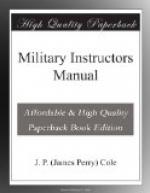At the discretion of the instructor the distance may be any number of paces, the men being first cautioned to that effect.
When distance is taken from the double rank, No. 1 of the rear rank follows No. 4 of the front rank, and he is in turn followed by the other numbers of the rear rank.
If the instructor desires the files to cover, he commands: In file Cover. Nos. 1 stand fast, the others moving to the right with the side step, until the Nos. 1 are covered.
To return to the original formation, the instructor commands: Assemble March. No. 1 of the front rank stands fast and the other members move forward to their original places.
Second Formation. To the right and left. Take interval, March.
Front Rank: Rear Rank: No. 1, 6 steps right step. No. 1, 3 steps right step. No. 2, 3 steps right step. No. 2, Stands fast. No. 3, Stands fast. No. 3, 3 steps left step. No. 4, 3 steps left step. No. 4, 6 steps left step.
Commands.
KINDS OF COMMANDS, AND HOW GIVEN.—There are two kinds, preparatory and executive.
The preparatory command describes and specifies what is desired and the executive command calls what has been described into action.
The tone of the command should always be animated, distinct, and of a loudness proportioned to the number of men for whom it is intended.
Instructors should cultivate a proper command, as its value as a tributary to the success of any military drill cannot be overestimated.
After an exercise has been described, its various movements or parts should be performed at executive words, which indicate not only the movement that is desired but the manner of the execution. Thus: 1. Trunk forward, 2. Bend, 3. Recover (or Raise), here the word bend is drawn to indicate moderately slow execution; the recovery being a little faster, the word recover should be spoken to indicate it.
The word Recover should always be used to bring the men back to the original position.
If it is desired to continue an exercise, the command Exercise should be used and the cadence or rhythm should be indicated by words or numerals. If numerals are used, they should equal the number of movements composing the exercise. Thus an exercise of two movements will be repeated at one, two; one of four movements will require four counts, etc.
The numeral or word preceding the command Halt should always be given with a rising inflection in order to prepare the men for the command Halt.
Thus: 1. Thrust arms forward, 2. Exercise one, two, one, two, one, Halt.
If any movement of any exercise is to be performed with more energy than the others, the word or numeral corresponding to that movement should be emphasized.




